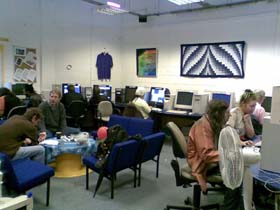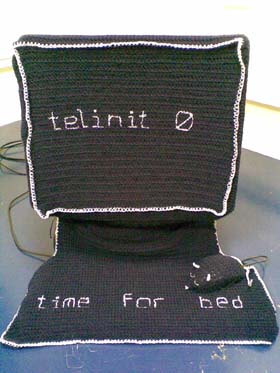|
Exhibitions Open Source Embroidery |
Introduction Exhibitions Html Patchwork Workshops Language Scarves Embroidered Digital Commons Links to interesting things
|










|
Open Sewing Circle |
Exhibitions
Open Source Embroidery
Introduction
Exhibitions
Html Patchwork
Workshops
Language Scarves
Embroidered Digital Commons
Links to interesting things










HV Galleri, Stockholm, Sweden
September 2010
Ele Carpenter, Kristina Lindström & Åsa Stahl, and others.
'Open Sewing Circle' is curated by Margareta Klingberg as part of the 'Points of Departure' series of exhibitions, discussions and events in Stockholm during September 2010. 'Points of Departure' presents contemporary art that has its starting point in the textile tradition and investigates an expanded field of new technologies, relational and activist practices within the public realm. The event is hosted by the Fiber Art Sweden (FAS) network as part of Northern Fibre, a recurring event in the Nordic countries last hosted by Sweden in 1995.
The 'Open Sewing Circle' exhibition and workshops will take place at the Handarbetets Vanners Galleri in Stockholm bringing together artists from the UK and Sweden who investigate the connection between textile and digital technology. The open sewing circle's will explore how cable, thread and wool mediate stories and contexts. Embroidery and knitting equates with programming and the creation of digital networks. The social openness of the traditional sewing circle is recreated in electronic networks. The work of the hand is combined with questions about communication networks.
Ele Carpenter will present a new series of embroideries based on Paul Baran's Network Diagrams featuring centralised, decentalised and distributed networks. Sewing Circle workshops will invite people to stitch their social networks, and to embroider a new term from Raqs Media Collective's 'The Lexicon of/for the Digital Commons'.
Past Exhibitions:
Open Source Embroidery
Museum of Craft and Folk Art, San Francisco, California, USA
2 October 2009 - 24 January 2010
Access Space, Suzanne Brook Martin, Ele Carpenter, Iain Clark, Emma Ferguson, Flare Productions, Paul Grimmer, Richard Hamilton, Suzanne Hardy, HUMlab Workers, James Hutchinson, Charlene Lam, Kristina Lindström & Åsa Stahl, Sampler Collective, Sophie McDonald & Davide Della Casa, Travis Meinolf, Kate Pemberton, Trevor Pitt, Michele Pred, Clare Ruddock, Hamilton, Southern & St Amand, Becky Stern, Haishu Zhang
The Open Source Embroidery exhibition presented artworks that use embroidery, thread and code as a tool for participatory production and distribution. It brought together individual and collectively made artworks by artists, makers, computer programmers and HTML users that explore the relationship between craft and code through social and digital networks.
Action Weaver Travis Meinolf and Ele Carpenter created a new work for the window at MOCFA. Weaving the Web is a 6x6ft weaving of red, green and blue internet cable which linked through a computer in the museum window to the internet. The work was inspired by Paul Grimmer's Ethernet (swatch) in the OSE exhibition.
The history of computing as craft began with the Jacquard Loom (1801), the first programmed machine which used binary punch cards to design woven patterns. The loom inspired Charles Babbage in his design of the Analytical Engine, often described as the precursor to the modern computer. Flare Productions documentary film about Ada Byron Lovelace To Dream Tomorrow (2003) highlights the signficance of her extensive notes about the Analytical Engine, and her insight into the potential of the machine to operate not just as a calculator of numbers but as a computer of symbols and information. Artist Richard Hamilton also featured Ada Lovelace in poster campaign to save free public entry for the South Kensington Museums in London (1998), (top left). These issues of access to culture and code are still pertinent questions of our time.
Open Source Embroidery was curated by Ele Carpenter, HUMlab Research Fellow in partnership with BildMuseet at Umeå University. This large scale exhibition has been developed by BildMuseet in Sweden and Museum of Craft and Folk Art in San Francisco, USA. Supported by Adobe Action Grants, Arts Council England, Canada Council, Fleishhacker Foundation, Galleria Park Hotel, San Francisco Arts Commission Organization Project Grant, and the San Francisco Foundation's 2009 Fund for Artists Matching Commission.
A pdf of the MOCFA OSE Exhibition Guide can be downloaded here.
Open Source Embroidery
BildMuseet, Umeå University, Sweden
6 June - 6 September, 2009
Access Space, Suzanne Brook Martin, Ele Carpenter, Iain Clark, Eclectic Tech Carnival, Emma Ferguson, Flare Productions, Paul Grimmer, Richard Hamilton, Suzanne Hardy, HUMlab Workers, James Hutchinson, Charlene Lam, Kristina Lindström & Åsa Stahl, Sampler Collective, Sophie McDonald & Davide Della Casa, Travis Meinolf, Kate Pemberton, Trevor Pitt, Michele Pred, Clare Ruddock, Hamilton, Southern & St Amand, Becky Stern, Haishu Zhang
The Open Source Embroidery exhibition presents contemporary artwork which uses embroidery and code as a tool to investigate participatory production and distribution methods. The project explores how the open source software development model has been incorporated into the language of cultural participation, involving interdisciplinary approaches to skill-share and collaboration. The exhibition includes material and digital works that make visible the physical characteristics of technology and social communications networks.
The exhibition at BildMuseet presented Kate Pemberton's new series Piracy Forever which depicts ASCI drawings included in .NFO files accompanying hacked software downloads. The exhibition opening featured a performance by the Sampler Culture Clash project. David Littler and Jason Singh used hand drawn embroidery patterns to create live sound mixes accompanying performance poet Yusra Warsama. Using open source software Hamilton, Southern & St Amand facilitated a new production of Running Stitch which has created a map of Umeå. Visitors to the OSE exhibition at BildMuseet were invited take a GPS walk around the city and sew their paths onto a giant canvas in the museum.
The Exhibition Guide for BildMuseet will soon be available to download here.
HUMlab Syjunta
HUMLab, Umeå University, Sweden
24 - 30 January, 2009
Ele Carpenter, Iain Clark, Paul Grimmer, Suzanne Brook Martin, Clare Ruddock, James Wallbank, Lisa Wallbank, Stefanie Wuschitz, Haishu Zhang and Open Source Embroidery Fika stitchers from Umeå.
HUMlab Syjunta was an intervention of patterned code and encoded craft into the HUMlab interdisciplinary digital humanities research lab at Umeå University, initiated by Research Fellow, artist and curator, Ele Carpenter. The project explored the characteristics of code and craft through material and online artworks that explore open methodologies and collective processes. All the works are described in the pdf HUMlab Syjunta Exhibition Guide.
This exhibition presented new work in progress created in HUMlab, including the collaborative HUMlab GYRMBC Tent, and the collectively stitched Yarn text. Individual works included Haishu Zhang's meticulously embroidered HUMlab logo, Stephanie Wuschitz's Wireless Women,and Suzanne Brook Martin's Knitted Pattern flat screen cover depicted here. The one-person GYRMBC (Get Your Rabbits Mated Before Christmas) Tent was created by HUMlab workers to illustrate the combination of RGB and CMYK colour sequences, and to recognise the need for individual creative space alongside the opportunity to collaborate with others.
During November 2008 the Open Source Embroidery Fika workshops at the Fine Art School and HUMlab inspired the stitching of the Raqs Media Collective's definition of Yarn (2003), which describes the metaphorical and material quality of threads, yarn and cables, and how they carry stories through weaving, stitching and bandwidth.
Open Source Embroidery: Craft + Code
Http Gallery, London, UK
16 May - 15 June 2008
Ele Carpenter, Iain Clark, Keith o'Faolain, Mark Gibbens, Paul Grimmer, Tricia Grindrod, Suzanne Hardy, Jake Harries, John Keenan, Trevor Pitt, Clare Ruddock, James Wallbank and Lisa Wallbank.
The exhibition at Furtherfield's Http Gallery in London presented the completed Html Patchwork, along side works made by artists and craftspeople at Access Space, and new works by Suzanne Hardy, Paul Grimmer and Iain Clark.
The exhibtion at HTTP presented the Knit-a-blog for the first time. Suzanne (glittrgirl) Hardy facilitated The Great International Knit-a-blog (2006-7) as a collectively knitted blog both in wool, and as a journal and online blog at: Knitted Blog Ele and Suzanne met at their local knitting group which meets at the Bridge Hotel in Newcastle every Tuesday evening.
Iain Clark first wrote his PHP Embroidery script for the Open Source Embroidery workshop at Connecting Principle: Process 2007. The work has beeen modified scince then, and now resembles a weaving pattern, with colours moving up the screen depending on the speed of your browser and internet connection. When Paul Grimmer asked Ele Carpenter to teach him how to knit network cable, they struggled for sometime before coming up with the idea of weaving. Paul built a weaving frame to create a weaving the same size as a computer monitor. In the exhibition at Http Gallery Paul Grimmer's 'Ether (swatch)' woven network cable connects Iain Clark's PHP Embroidery to the network. The cource code to the PHP Embroidery is available to take away on a print out. The PHP Embroidery is reminscent of early net art, using the internet as a space in which to create artwork. The work uses a command to repeat refresh the page. Each time the page is refreshed the co-ordinates of the colour spaces and frequencies are replotted. To view the work directly from the server see PHP Embroidery, Iain Clark.
Open Source Embroidery
Access Space, Sheffield, UK
Sept - Nov 2007
Ele Carpenter, Keith o'Faoláin, Mark Gibbens, Tricia Grindrod, Jake Harries, John Keenan, Trevor Pitt, Clare Ruddock, James Wallbank and Lisa Wallbank.
Open Source Embroidery is a socially engaged new media craft project initiated by Ele Carpenter exploring the similarities between Open Source software and the collaborative characteristics of needlework crafts. This exhibition presented the Html Patchwork as a work in progress, alongside creative projects by artists, computer users and craftspeople in Sheffield and beyond.
Patchwork reuses fabric to make new textiles, and is designed and pieced together by networks of quilters. Many of the designs explore mathematical sequences. Tricia Grindrod runs the Patchwork Garden Shop in Sheffield, and generously loaned her Bargello patchwork for the exhibition.
People at Access Space contributed to the Html Patchwork and created new works for the exhibition including: Keith o'Faoláin's animation of the 216 hexadecimal colours used in the Html Patchwork; Lisa Wallbank's crocheted telnit 0: time for bed computer and mouse cover; John Keenan's embroidered T-shirt and baseball cap; and an Electronic Embroidery sound T-shirt by Keith o'Faoláin and Jake Harries, performed at the preview. Mark Gibbens created a hexagonal biscuit cutter from an old computer case to make biscuits for the exhibition preview. James Wallbank's Hexart GDlib Script Error emerged by accident while he was writing the code that creates the display of 216 websafe colours for the Html Patchwiki.The Patchwiki can be found through Html Patchwork page of this site, and is documented on Ele's Blog.
The exhibition included html embroidery by Ele Carpenter stitching onto fabric and clothing in response to specific conversations or events, as described on the workshops page of this website. Clare Ruddock, Newcastle upon Tyne, makes Calling Cards embroidering web addresses onto handkerchiefs, combining the romance of a Victorian lady dropping her handkerchief and the formal business card or email signature. See Clare's Blog. The exhibition also presented the 'Soft Bench Knitting Pattern' knitted by ladies from the Glebe Farm Estate, facilitated by Trevor Pitt, Birmingham, 2005. The ladies wrote out their patterns for each part of the bench. See the designed knitting pattern Soft Bench Knitting Pattern.